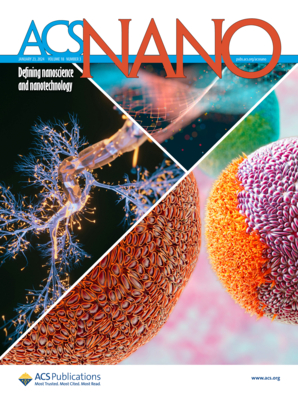Kinetically Controlled Mesoporous Silica Films for Quasi-3D Nanoconfinement of Semicrystalline Polymers below Their Lamellae Dimensions.
IF 16
1区 材料科学
Q1 CHEMISTRY, MULTIDISCIPLINARY
引用次数: 0
Abstract
Mesoporous silica thin films are candidates for next-generation dielectric materials due to their potential for control over their texture, high surface area, and good dielectric properties. Further, their dielectric response can potentially be further modified by infiltrating a second phase such as a polymer to produce thin film nanocomposite dielectrics. Despite their potential, uptake of mesoporous silica thin films has been hindered by difficulties in controlling the nanoscale structure and silica texture. We employ advanced characterization and kinetic Monte Carlo modeling to identify critical synthesis parameters governing the mesoporous silica texture. Different degrees of pore ordering can be achieved from quasi-random to highly ordered, eliminating the trial-and-error typically associated with achieving a targeted nanostructure. We then infiltrate semicrystalline poly(vinylidene fluoride) and polypropylene into the sub-10 nm pores to completely suppress the formation of crystalline domains in the polymers and produce nanocomposite dielectrics. Polypropylene nanocomposite dielectrics exhibit dielectric constants ∼20% higher than silica and 125% greater than those of polypropylene. Poly(vinylidene fluoride) nanocomposites exhibit relaxor ferroelectric behavior. These dielectric materials are enabled by controlled, hierarchical design that spans the self-assembly of the silica matrix, tuning of the pore surface chemistry, and modification of the polymer conformations through the resulting quasi-3D nanoconfinement. We believe that these nanocomposites represent a powerful platform for the study of polymers under extreme levels of confinement, as well as a potential platform for next-generation dielectric materials.动力学控制介孔二氧化硅薄膜准三维纳米约束的半晶聚合物低于其片层尺寸。
介孔二氧化硅薄膜是下一代介电材料的候选者,因为它们具有控制纹理、高表面积和良好介电性能的潜力。此外,它们的介电响应可以通过渗透第二相(如聚合物)来产生薄膜纳米复合介电材料,从而有可能进一步改变。尽管介孔二氧化硅薄膜具有潜力,但由于难以控制纳米级结构和二氧化硅结构,其吸收一直受到阻碍。我们采用先进的表征和动力学蒙特卡罗模型来确定控制介孔二氧化硅结构的关键合成参数。可以实现从准随机到高度有序的不同程度的孔隙有序,从而消除了通常与实现目标纳米结构相关的反复试验。然后,我们将半晶聚偏氟乙烯和聚丙烯渗透到10 nm以下的孔隙中,以完全抑制聚合物中晶体域的形成,并生产纳米复合电介质。聚丙烯纳米复合材料的介电常数比二氧化硅高20%,比聚丙烯高125%。聚偏氟乙烯纳米复合材料表现出弛豫铁电行为。这些介电材料是通过可控的分层设计实现的,这种设计跨越了二氧化硅基体的自组装、孔表面化学的调整以及通过由此产生的准3d纳米限制对聚合物构象的修饰。我们相信,这些纳米复合材料代表了一个强大的平台,用于研究极端限制水平下的聚合物,以及下一代介电材料的潜在平台。
本文章由计算机程序翻译,如有差异,请以英文原文为准。
求助全文
约1分钟内获得全文
求助全文
来源期刊

ACS Nano
工程技术-材料科学:综合
CiteScore
26.00
自引率
4.10%
发文量
1627
审稿时长
1.7 months
期刊介绍:
ACS Nano, published monthly, serves as an international forum for comprehensive articles on nanoscience and nanotechnology research at the intersections of chemistry, biology, materials science, physics, and engineering. The journal fosters communication among scientists in these communities, facilitating collaboration, new research opportunities, and advancements through discoveries. ACS Nano covers synthesis, assembly, characterization, theory, and simulation of nanostructures, nanobiotechnology, nanofabrication, methods and tools for nanoscience and nanotechnology, and self- and directed-assembly. Alongside original research articles, it offers thorough reviews, perspectives on cutting-edge research, and discussions envisioning the future of nanoscience and nanotechnology.
 求助内容:
求助内容: 应助结果提醒方式:
应助结果提醒方式:


